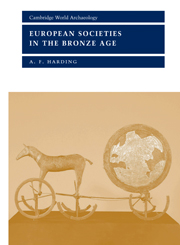Book contents
- Frontmatter
- Contents
- List of figures
- List of tables
- Preface
- 1 Introduction
- 2 The Bronze Age house and village
- 3 Burial
- 4 The domestic economy
- 5 Transport and contact
- 6 Metals
- 7 Other crafts
- 8 Warfare
- 9 Religion and ritual
- 10 Hoards and hoarding
- 11 People
- 12 Social organisation
- 13 The Bronze Age world: questions of scale and interaction
- 14 Epilogue
- References
- Index
2 - The Bronze Age house and village
Published online by Cambridge University Press: 25 January 2010
- Frontmatter
- Contents
- List of figures
- List of tables
- Preface
- 1 Introduction
- 2 The Bronze Age house and village
- 3 Burial
- 4 The domestic economy
- 5 Transport and contact
- 6 Metals
- 7 Other crafts
- 8 Warfare
- 9 Religion and ritual
- 10 Hoards and hoarding
- 11 People
- 12 Social organisation
- 13 The Bronze Age world: questions of scale and interaction
- 14 Epilogue
- References
- Index
Summary
Bronze Age life was for the most part a life based in agricultural villages. Few of these villages possessed houses of special size or elaboration. In most parts of Bronze Age Europe they are unspectacular affairs, no more than clusters of pits and post-holes, or cooking places marked by accumulations of fired stones, discovered by chance during development work or the excavation of sites of a different period. The study of Bronze Age settlements is possible to differing degrees in different parts of Europe, as a result of differential survival and differential success at extracting the necessary information from the archaeological record. Spectacular discoveries in a few areas are balanced by an almost complete absence of known sites in others.
That the fugitive traces of Bronze Age house sites can reflect stable and long-lived settlement has been apparent since the work of Strömberg and Stjernquist on the settlement sites of Scania. Settlement traces which on the basis of a few good plans can be reconstructed to something much bigger can be found in many areas, and emanate from all parts of the Bronze Age. The remains of hearths, ovens and cooking places are often found; some were originally inside buildings, others outside. Analysis of the internal structure of Bronze Age settlements defined only by pits identified clusters that might correspond to original activity foci, probably houses and their associated activities (a cluster being a grouping of potentially contemporary features which represent a non-coincidental agglomeration).
- Type
- Chapter
- Information
- European Societies in the Bronze Age , pp. 22 - 72Publisher: Cambridge University PressPrint publication year: 2000



